Delays, cancellations, exorbitant airfares and even the sudden annihilation of an airline – there are many factors holding rural Australians back from becoming frequent flyers. With capital city dwellers able to make lengthy interstate journeys for the same price, or cheaper, than booking a last-minute regional flight, the sense of inequality is widely felt. And due to the unreliability of regional air travel, even long-made plans can come undone.
The Campbell family farms cotton, chickpeas and wheat near Narrabri – a North West NSW town whose airport struggles to provide a consistent service to Sydney. In December 2013, the family members were planning a reunion at the farm to celebrate Christmas. “My two sisters and I were coming from Sydney, my brother was coming from Malaysia with his wife and their baby, so we were going to all fly from Sydney to Narrabri. We’d booked our flights well in advance for about $200 because we knew they were going to be expensive,” explains Bel Campbell.
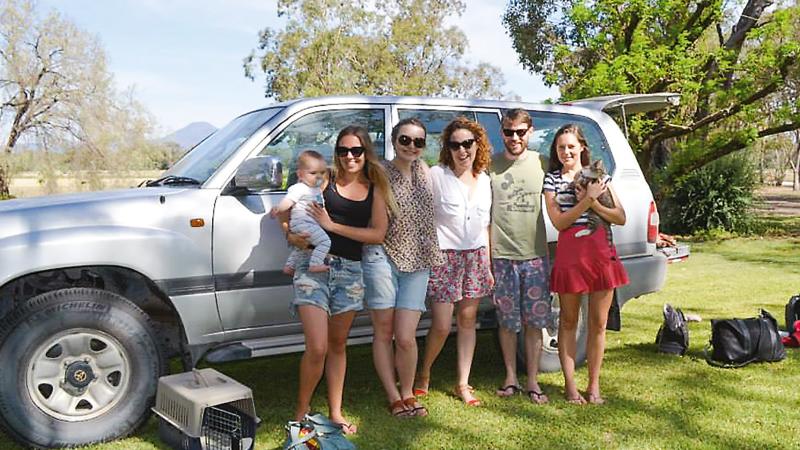 The three Campbell sisters Sally, Julia and Bel, their brother Sandy, his wife Carla Prowse and baby George – plus the family cat Besito – travel in a Landcruiser from Sydney to Narrabri at Christmas 2013. Their flights were cancelled after their airline went into receivership.
The three Campbell sisters Sally, Julia and Bel, their brother Sandy, his wife Carla Prowse and baby George – plus the family cat Besito – travel in a Landcruiser from Sydney to Narrabri at Christmas 2013. Their flights were cancelled after their airline went into receivership.
But their careful planning was soon undone. “In October we heard the carrier, Brindabella Airlines, was going into receivership and it closed in December,” Bel says. “We didn’t get our money back, and it was too late to find affordable alternative flights to Narrabri or Moree. My parents ended up driving to Sydney to leave a car for us – an eight-seater Landcruiser – so we drove home with five adults, my brother’s baby and our cat.” Stories like the Campbells’ – and graver tales of funerals and health appointments missed – have become everyday conversations in many communities.
FLIGHT CANCELLATIONS AND CUTS: A CAUSE FOR CONCERN
A spike in cancellations last year, flight cuts by regional carriers and all the experiences of hassle and expense have now spilled into formal action. In November 2017, the Australian
Senate’s Rural and Regional Affairs and Transport References Committee launched an inquiry into the operation, regulation and funding of air route service delivery to rural, regional and remote communities. It is due to report in September.
Submissions have come from around Australia and hearings have been held to date in the Northern Territory, Queensland and Western Australia. The inquiry has flagged hearings for NSW in July. Says committee member Senator Slade Brockman: “We’re hearing from people not being able to make business appointments, people not being able to get to events or medical appointments in the city, and people who are waiting for supplies or parts to arrive via an aircraft.”
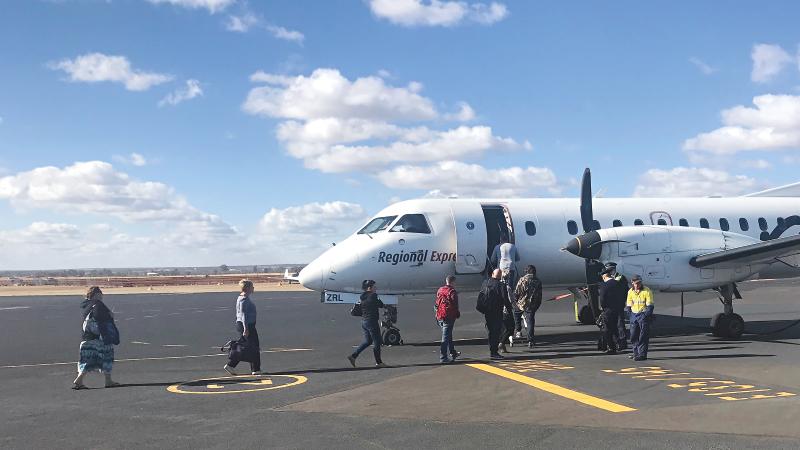 Passengers finally board a flight from Dubbo City Regional Airport to Sydney in May. Their earlier service had been announced delayed, then cancelled – leaving them with a five-hour wait.
Passengers finally board a flight from Dubbo City Regional Airport to Sydney in May. Their earlier service had been announced delayed, then cancelled – leaving them with a five-hour wait.
According to the Australian government, 10,808 domestic flights were cancelled in 2017, comprising 1.9% of scheduled services – higher than the long-term average of 1.4%. Several carriers responded by paring back flights. In late 2017, QantasLink announced it was adjusting schedules to “deal with pilot resourcing issues and improve overall reliability”. It reduced flights but used larger aircraft on some regional routes to preserve capacity, with these schedules carrying over into 2018.
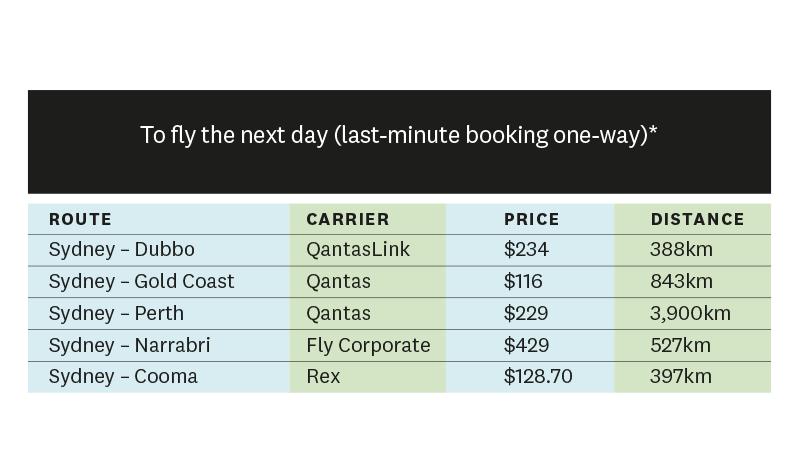
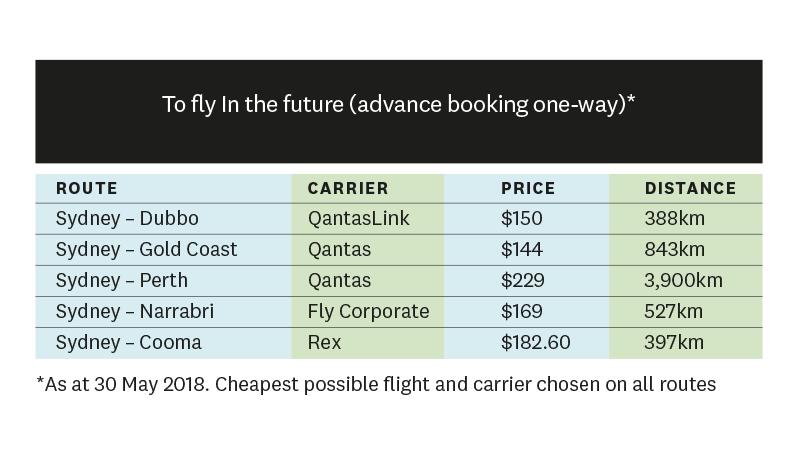
The airline said routes using Turboprop engine planes and Boeing 717s in NSW and Queensland were the most affected, with an average capacity reduction of 8%. As a result of these adjustments, cancellations across regional NSW fell from an average of 5.7% in October 2017 to 0.8% in April 2018, QantasLink said.
Despite recent acute challenges, the problem isn’t new. Sarah Baglee and her husband Clinton live on a small farm just outside Coonabarabran in Central West NSW, while their two children serve in the army – Maddy at Townsville in northern Queensland and Alex at Puckapunyal in central Victoria. Such are the logistics for Alex of getting from Puckapunyal to Dubbo City Regional Airport via Sydney, then home to Coonabarabran, that he usually just drives. It’s a 10-hour journey.
REGIONAL FAMILIES FACE SKY-HIGH AIRLINE PRICES
When Maddy returned home at Easter, it cost close to $700, a standard price – or more – for the convoluted journey. “It’s impossible,” Sarah says. “Maddy always has to overnight in Sydney if she wants to fly via Dubbo, and then it’s a two-hour drive.”
Sarah has found that flights from Tamworth Regional Airport are significantly cheaper, to the point it is often worth driving to that airport, which is further away. “Price-wise it’s just what we need to do, it’s always at least $125 cheaper. You’re still flying Regional Express (Rex) or JETGO or Qantas, so I don’t really understand why it’s a different price,” she says.
In regional NSW, competition differs from airport to airport. For some, like Griffith Airport, Rex is the sole operator, although EastWest Airlines is poised to reinstate the Griffith-Melbourne route.
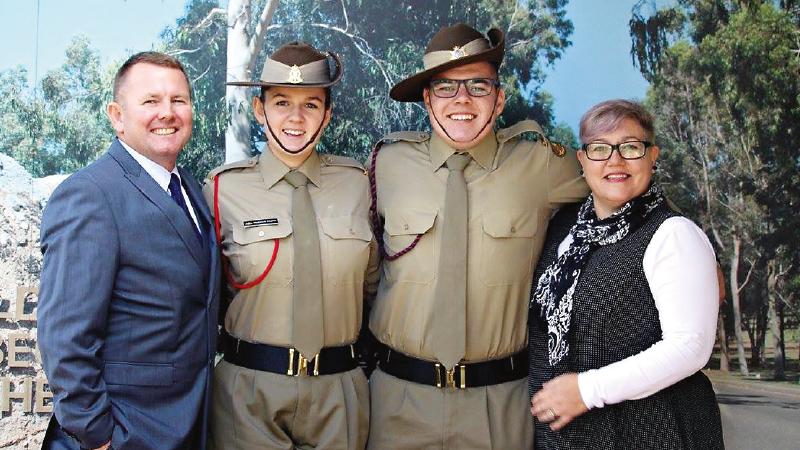 Clinton and Sarah Baglee with their army-serving children Maddy and Alex, who face lengthy journeys home to Coonabarabran.
Clinton and Sarah Baglee with their army-serving children Maddy and Alex, who face lengthy journeys home to Coonabarabran.
For the Baglee family, it’s hard to discern why a range of carriers – Rex, QantasLink, JETGO and FlyPelican – at Dubbo doesn’t result in airfares competitive with those at Tamworth, serviced by Qantas, Virgin Australia and Fly Corporate. Other than a longer drive, there are additional challenges in flying in and out of Tamworth for Maddy. She needs to be in town at 6.30am in time to catch her connecting flight to Townsville, so the family drive her in the night before and stay overnight in a motel. Meanwhile, her home-bound flight to Tamworth arrives about 8pm. “Then you’ve got to beat the kangaroos and the wild goats on the road to get home,” Sarah says. “Last time we counted 43 roos from Tamworth to Coonabarabran.”
A NSW Farmers’ spokesperson for rural affairs agrees an expensive airfare is only the tip of the iceberg for those living in regional areas. “There’s a safety impact, and health and wellbeing issues. It’s easy to get on a plane and fly. It’s much harder to make an eight-hour drive to get on a plane, fly to Sydney, and then turn around the next day and do it in reverse,” the spokesperson says.
While innovations in telecommunications, remote education and e-health can connect people to resources: “We also recognise that people-to-people interactions are really important.” And getting user demand to make regional routes more competitive is often a ‘chicken and egg’ question. “If airlines were prepared to lower the cost of flights, that would stimulate travel and lead to an increase in the availability of service – it’s that requirement of demand,” the spokesperson says. “But in recognising that costs borne by airlines on rural routes can be particularly expensive, we don’t seem to coordinate our public transport infrastructure terribly well.”
Senator Slade Brockman says while it’s too early to discuss the inquiry’s recommendations, at the heart of the matter are solutions to an evident problem. “We’ll be discussing with regulators ideas to improve efficiency, lower costs and get better synergies between airports.” He notes access to regional airlines varies from region to region, with smaller centres facing greater challenges.
“There is no silver bullet for airfare costs for regional Australia. However, what the inquiry will endeavour to uncover are areas where we can make sure costs are minimised and driven down as much as possible.
”
Competition is one area the inquiry will explore, and a range of interest-focused reports have recently emerged. Airlines for Australia and New Zealand – a group representing Air New Zealand, Jetstar, Qantas, Rex, Tigerair and Virgin Australia – published a report on alleged price gouging by privatised airports. The report, released in May, states: “Australian passengers and our economy are paying the price of airport privatisation in the absence of appropriate constraints on monopoly power.” It’s a refrain airlines have made before. In a February submission to the inquiry, Rex says: “While Sydney Airport pricing is declared, all other capital city airports are not similarly regulated, resulting in unbelievably high airport charges.”
The airline also refutes expectations that greater competition equals greater affordability. “Rex would like to state categorically for the record that, contrary to popular folklore, competition in regional aviation can be particularly detrimental for all the smaller routes of less than 100,000 passengers a year.”
COST VS CONVENIENCE FOR RURAL RESIDENTS
Federal Assistant Minister for Trade, Tourism and Investment Mark Coulton offers a similar caution. “It’s not always the best result for a country airport to attract a cut-price carrier that has a bigger plane that might only fly once a day. At the moment in Dubbo we have Qantas and Rex on those busier routes, providing a choice of around eight to 10 flights a day at different times.”
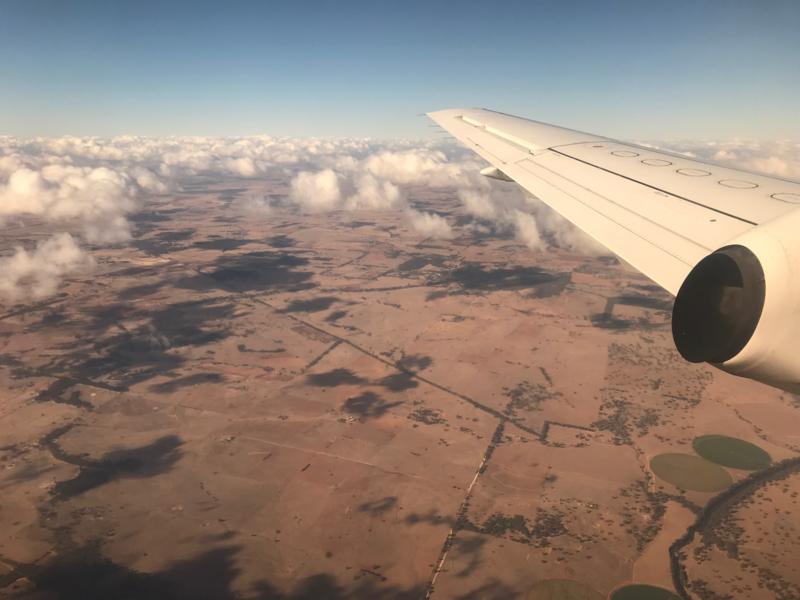 FLIGHT PATH: Dubbo to Sydney route, from the sky.
FLIGHT PATH: Dubbo to Sydney route, from the sky.
To take the sting out of pricing, airlines recommend booking early, flying off-peak and watching for sales. To Sarah Baglee, however, knowing of special fare deals isn’t the same as nabbing one. “Airlines say they’ve got these great flights from Dubbo to Melbourne or Tamworth to Brisbane, but I’ve never been able to fluke one,” she says.
The Isolated Children’s Parents’ Association of Australia, in its submission to the inquiry, also points to the impracticality of being expected to book strategically. “There are rarely ‘inexpensive’ airfares available that coincide with school holidays,” the submission says. “As so many Australians travel during this period, it sees peak bookings and prices. However, this is the time that students who need to live away from home in order to access schooling must travel to and from school/home.” It asks that governments consider further subsidisation of rural and remote routes, satisfying a demonstrated need, not just commercial viability. Assistant Minister Coulton says subsidies have their place. “I believe the NSW government are looking at setting money aside to subsidise those smaller ‘milk runs’ that might go to places like Walgett, Bourke and Cobar,” he says. “They only work if they have some kind of subsidy – it’s very hard to keep the numbers up. “Narrabri is a particular concern, as they put a lot of money into their airstrip but they’re struggling to run a Sydney flight.”
While families like the Campbells may laugh about their Christmas journey, many struggle to get around the problem. Almost 200 submissions to the inquiry detail the social, health and business impacts of expensive airfares and limited schedules. While the inquiry’s report may not offer a “silver bullet”, it can only be hoped farmers will eventually notice a difference when they next book a ticket.
A MATTER OF SECURITY
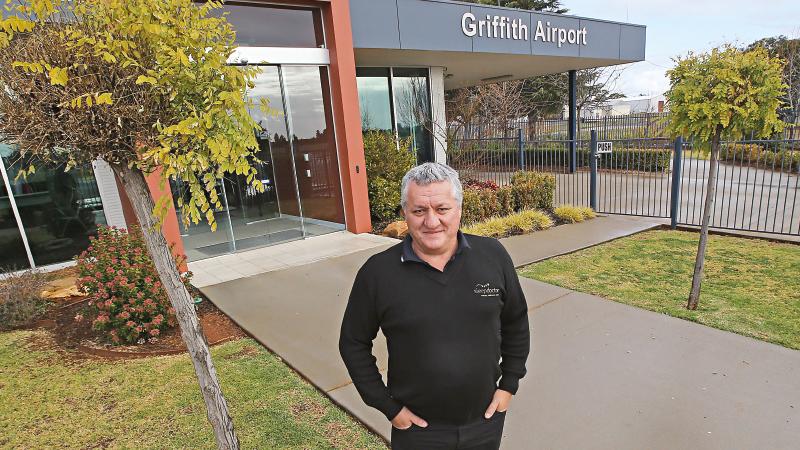 Paul Pierotti President, Griffith Business Chamber - “I was quite shocked. I would have thought it made sense to apply that support here in Griffith.”
Paul Pierotti President, Griffith Business Chamber - “I was quite shocked. I would have thought it made sense to apply that support here in Griffith.”
In the May 2018 Federal Budget, the government announced a $294 million package for increased airport security – with $50.1 million earmarked over the next four years for upgrades to 64 regional airports.
Not all regional areas will benefit, however. Many in Griffith in the Riverina region of NSW are disappointed to discover that their airport will be missing out. “I was quite shocked actually, as I would have thought it made sense to apply that support here,” says Paul Pierotti, president of the Griffith Business Chamber.
Security is a prerequisite for airports that receive passenger aircraft exceeding 20 tonnes. Rex is currently the sole carrier operating from Griffith, flying an aircraft that is under the 20-tonne limit.
“We would like the state or federal government to fund security implementation into Griffith Airport,” Paul says, arguing that this will enable growth, competition and better access. He adds that annual passenger numbers, currently around 70,000, are projected to reach 120,000 by 2025.
“Our airport was upgraded only a couple of years ago, including the tarmac and the parking area for certain larger jets. It’s also security-ready,” he says.
The city of Griffith bills itself as the regional capital of the Western Riverina, the largest winemaking area in the state and a major growing district of rice, cotton, citrus, almonds, walnuts, chickens and more. As Griffith is a six-and-a-half-hour drive from Sydney and five hours from Melbourne, transport is vitally important to the economy.
Paul says a Griffith Business Chamber poll revealed that 92% of local businesses would be prepared to pay a $10 ticket surcharge to support security implementation at the airport.
“We will need security at some point,” he says. “For all public passenger transport options that go into major metropolitan cities, it’s inevitable.”